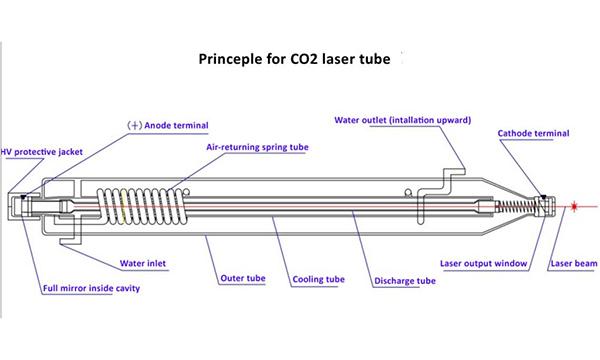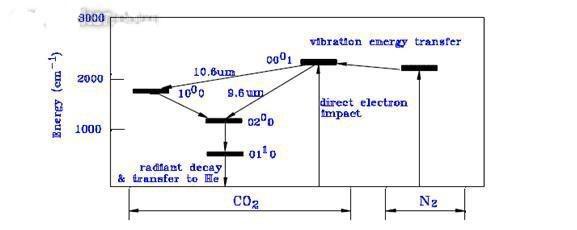Structure of CO2 laser

The basic structure of a typical sealed off CO2 laser tube is shown in the above figure. It consists of three parts: hard glass, resonant cavity and electrode.
1. hard glassThe component is composed of a GG17 material fired into a discharge tube, a water-cooled tube, a gas storage tube and a tube for gas circulation. The discharge tube is the key component in the CO2 laser, which basically determines the characteristics of the laser output, and the length of the discharge tube and output power are just proportional. The function of the water-cooled tube is to cool the laser gas to ensure the output power stable, and protect the discharge tube from being thermally degenerated during discharge pumping. The function of the gas storage pipe increases the gas storage capacity of the gain medium on the one hand, reduces the change of the working gas composition and pressure during the working process, prolongs the operation life, and enhances the mechanical strength and stability of the discharge tube. The return air pipe is a thin spiral pipe connecting the two electrode spaces in the discharge tube, which can improve the imbalance distribution of the interelectrode voltage caused by the electrophoresis phenomenon, and the longer return air pipe also avoids the discharge between the gas storage tank and the electrode, ensuring the discharge only occurs in the discharge tube.
2. Resonant cavity
This part consists of a full mirror and an output mirror. The full mirror of the cavity is generally based on optical glass, and the surface is gold-plated. The reflectivity of the gold mirror near 10.6um is over 98%. The output mirror of the cavity is generally made of infrared material that can transmit 10.6um. Ge is the substrate, it becomes the full mirror in tube with layers of dielectric film coated on.
3. Electrode part
CO2 lasers is generally made with a cold cathode in a cylindrical shape. The cathode material has a great influence on the life of the laser. The basic requirements for the cathode material are: low sputtering rate and low gas absorption rate.
CO2 laser tube working theory
The CO2 molecule is a linear symmetric molecule, and the two oxygen atoms are on either side of the carbon atom, which represents the equilibrium position of the atom. The atoms in the molecule are always moving, and they are constantly vibrating around their equilibrium position. According to molecular vibration theory, CO2 has three different vibration modes:

Energy level
A carbon dioxide laser is a molecular laser. The main substance is carbon dioxide molecules. It can represent a variety of energy states depending on the form of its vibration and rotation. The basic energy network is shown in Figure 1. The mixed gas in carbon dioxide is a plasma (plasma) formed by a low-pressure gas (usually 30-50 Torr) due to electron emission. As stated by Maxwell-Boltzmann's law of distribution, molecules exhibit a variety of excited states in the plasma. Some will exhibit a high energy state (00o1) which behaves as an asymmetrical swing state. When colliding with a hollow wall or naturally emitting, this molecule also accidentally loses energy. By naturally emitting this high energy state, it will fall to a symmetrical oscillating form (10o0) and emit photons (a beam of 10.6 μm wavelength) that may propagate in any direction. Occasionally, one of these photons will travel down the cavity of the optical axis and will also oscillate in the resonance mirror.
Excition Process
In the CO2 laser tube, the main working substance consists of three gases: CO2, nitrogen and helium. Among them, CO2 is a gas that generates laser radiation, nitrogen and helium are auxiliary gases. With helium, it can accelerate the 010 energy level heat relaxation pre-process, which is more conducive to the evacuation of laser energy levels 100 and 020. The addition of nitrogen mainly acts as an energy transfer in the CO2 laser tube, which plays a powerful role in the accumulation of the number of energy levels on the CO2 laser and the high-power and high-efficiency laser output. Excitation conditions of the CO2 laser tube: In the discharge tube, a direct current of several tens of mA or several hundred mA is usually input. At the time of discharge, nitrogen molecules in the mixed gas in the discharge tube are excited by the impact of electrons. At this time, the excited nitrogen molecules collide with the CO2 molecules, the N2 molecules transfer their energy to the CO2 molecules, and the CO2 molecules transition from the low energy level to the high energy level to form a particle number reversal to emit laser light.
Note: Some pictures and info are from the network


